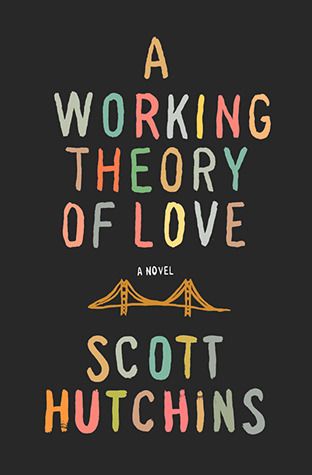Relationships
Can Computers Think? Can Men Feel?
Debut novelist approaches love and feelings in an original way.
Posted October 26, 2012

Not an unusual set-up for a debut novel: A divorced man in his mid-30s moves to San Francisco and begins dating.
But then there's the fresh slant: protagonist Neill Bassett, Jr., is also working on a computer project intended to replicate a human personality and pass the test designed by computer scientist Alan Turing, back in 1950. Can a computer think? Can it feel?
Based on Neill's dead father's journals, a personality seems to be developing inside the computer. And many of the conversations he (it?) has with Neill terminate when the "father" gets too close to finding out he's killed himself.
Sex, cults, anomie, San Francisco, love, and grief all figure in a major way in Scott Hutchins' A Working Theory of Love. I found it funny, warm, thought-provoking, and realistic when it comes to relationships. Scott Hutchins was a Truman Capote Fellow in the Wallace Stegner Program at Stanford University, where he currently teaches.
My Q&A with Scott Hutchins:
Q: How plotted-in-advance was this novel, and how much was written in a flow state, where time seems to stop and scenes come more easily?
Most of the novel was written in something more like a flow state—but not in any particular order. I had locked in on Neill’s voice (Neill is the narrator), and I would sit down and handwrite a couple of pages here and there as I scraped together work and life. I didn’t write sequentially. It was a really odd way to build a book and made me very nervous the whole time, but it was how I was writing—how the book needed to be written.
Of course, I hope that method is invisible to the reader. I've done my best in revision to make it seamless—and, believe me, revision was no flow state.
Q: You wrote about the narrator's father being "inside" the computer, in a way. Did you use an object or a photo to concretize the idea of a sentient computer as you wrote?
I didn't. I thought that looking at the computer would be too physical—the separation between the silicon-based stack and the ineffable father would be underlined, rather than erased. To me, the father exists in language and intention. That's the way in which he's "inside" the computer. In his new incarnation, he's a series of patterns interacting with other patterns on physical hardware—which is more or less what he was when he was alive.
Q: Speaking of images, are you a visual person who "saw" the scenes unfolding inside your head?
I would say I "heard" them. In other words, the voice spoke and I channeled that speech. Which is not to say I didn’t see much of it as well, but I'm not a writer who has cinematic visions that I'm merely recording. I'm conscious of creating the world of the novel.
Q: A lot of fiction (especially debut novels, they say) are autobiographical. I'm just wondering how different the creative process felt for you when you were totally inventing and when you were creating fiction from lived experiences?
For me it’s harder to work with autobiographical material. It feels very exposed. That said, in writing A Working Theory of Love, I treated my own life the same way I treated everything else around me—as material. I plucked cold-bloodedly from my own life. A scene that actually happened to me might be recast in another emotional context (a nice afternoon becomes fraught, for example) or a strong emotion I actually experienced might be aligned with a wholly invented scene. Nothing in the book is straight autobiography, but I enjoyed the power that comes with working close to the bone. If I can feel it in my gut, then the reader is much more likely to feel it in his or hers.
Q: The whole Alan Turing centenary connection: how did you happen to time that just right?
Sheer coincidence. I didn’t realize it was the centenary year of Turing’s birth until my editor pointed it out.
Q: In your press materials, you said you would give yourself good marks on your persistence. That skill or habit is so important to a writer. Were you always the type to get your homework in on time, or how did and does this persistence manifest in your life besides in writing?
I spent my K-12 being very lazy. I would eventually get everything done, but the highest achievement was to scrape by with good grades while doing the bare minimum. That was the game, the true definition of being smart. When I went to college I realized I didn’t want to be that kind of student—actually couldn’t be that kind of student. I wasn’t smart enough; I was going to have to work for things.
That realization was a great gift. It changed the kind of person I wanted to be in the world. I wanted to show up. I wanted to be there on time (previously I was always late). I wanted to be challenged, to be awake. I don’t think I could have put these urges into words the way I am now, but they were powerful and I’m so glad I let them take hold of me. They eventually brought me to writing, because I could tell writing would challenge me for the rest of my life. There are no plateaus in writing.
Of course, that was a romantic youthful notion. If I’d known how hard writing actually would be, I might have tried to improve my scores on the GMAT.
But back to persistence…I would say persistence has become such a part of me that my real challenge is letting go. In many ways, writing A Working Theory of Love required me to let things come. To alternate persistence with openness. To trust the process—and ultimately to trust myself.
Q: A Working Theory of Love is an actual hardcover book, made out of paper. Wow. Would you have been as excited if it only came out in e-book form?
Hmm. Hard to say, but I would guess not! To hold the book in my hands and feel its heft is really something. Also—and I can say this because I had nothing to do with the design—it’s a good-looking item. It’s something I like to look at and hold and turn over. Hopefully, others will feel that way as well.
- Read another interview with Scott.
- See the book trailer and more.
Copyright (c) 2012 by Susan K. Perry




